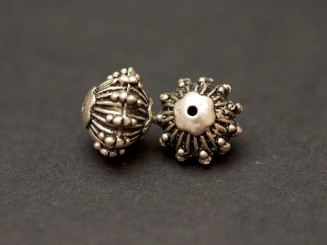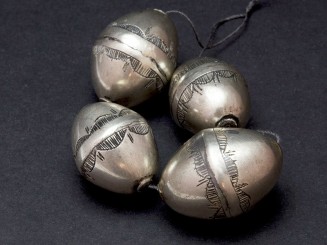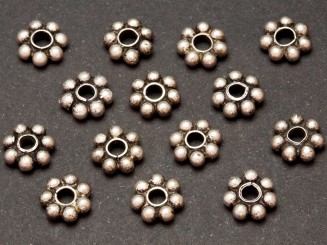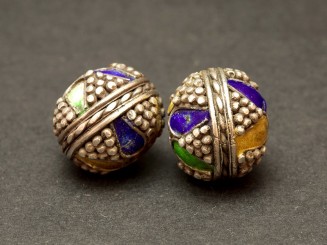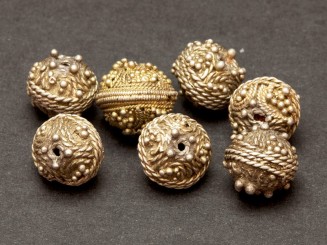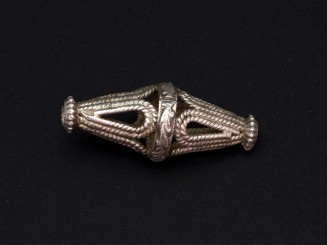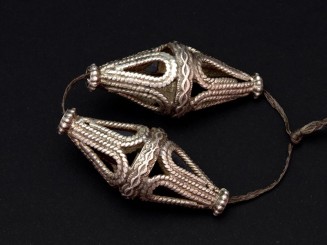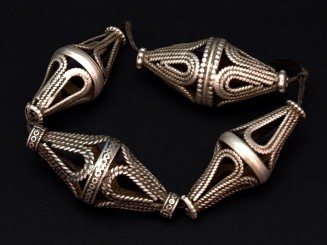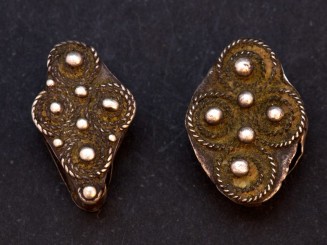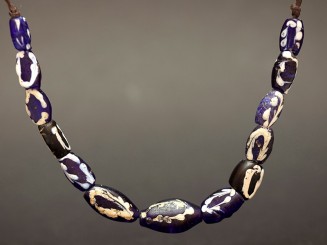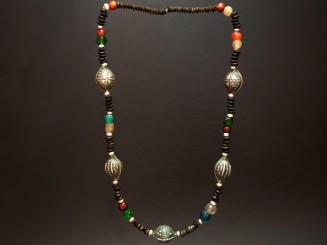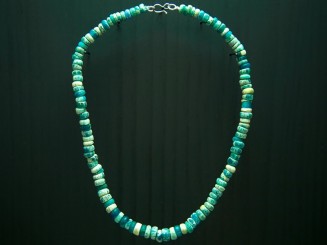Beads
-
Price €39.00MA0905-741
A lovely Moroccan Berber old silver plaque with beatiful incise decoration. Pieces like these were sewn in rows on textile or leather pieces making beautiful headbands. They were often combined with some other elements such as coral, amzonite, silver coins, trade beads to a most flamboyant result.
-
Price €16.00MA1016-365
Two beautiful old Berber silver beads fetauring a great filigree work. Superb.
-
Price €98.00MA1016-359
A great set of four old bereber engraved silver beads. Great patina.
27 x 20 mm
25 x 20 mm
25 x 18 mm
23 x 18 mm
-
Price €39.00MA1016-371
Fifteen beautiful old Berber silver beads fetauring a great work. Superb.
-
Price €39.00MA1016-370
Twelve beautiful old Berber silver beads fetauring a great work. Superb.
Entre 10 y 12 mm de diametro x 2 mm ancho
-
Price €46.00MA1016-361
Two beautiful old Berber silver and enamel beads fetauring a great granulation work. Superb.
-
Price €95.00MA1016-360
Six beautiful old Berber silver beads fetauring a great filigree work. Superb.
-
Price €125.00MA1016-588
Seven outstanding silver old beads with traces of gilding bath. Featuring an intricate work of granulation and filigree very characteristic of Mauritanians goldsmiths. Very rare to find especially in good condition. Beautiful patina. Beginning of the 20th century
-
Price €125.00MA1016-587
Six outstanding silver old beads with traces of gilding bath. Featuring an intricate work of granulation and filigree very characteristic of Mauritanians goldsmiths. Very rare to find especially in good condition. Beautiful patina. Beginning of the 20th century
-
Price €225.00MA1016-586
Sixteen outstanding silver old beads with traces of gilding bath. Featuring an intricate work of granulation and filigree very characteristic of Mauritanians goldsmiths. Very rare to find especially in good condition. Beautiful patina. Beginning of the 20th century
-
Price €180.00MA1016-585
Fifteen outstanding silver old beads with traces of gilding bath. Featuring an intricate work of granulation and filigree very characteristic of Mauritanians goldsmiths. Very rare to find. Beautiful patina. Beginning of the 20th century
-
Price €195.00MA1016-558
Ten precious silver old beads with traces of gilding bath. Featuring an intricate work of granulation and filigree very characteristic of Mauritanians goldsmiths. They are used as part of necklaces and they can also be seen decorating the haird of Maure ladies. This kind of beads are very scarce nowadays. Beautiful patina. Beginning of the 20th century.
4 pieces 15 mm high, 4 pieces 17 mm high, 1 piece 18 mm high y 1 piece 20 mm high.
-
Price €32.00MD0913-333
Beautiful Afghan old oval silver bead featuring a great silver openwork and a great patina. Superb patina.
-
Price €75.00MD0913-334
Beautiful Afghan old oval silver beads featuring a superb silver openwork and a great patina.
-
Price €124.00MD0913-337
Beautiful Afghan old oval silver beads featuring a superb silver openwork and a great patina.
-
Price €55.00MD1115-511
A superb pair of antique Mauritanian silver beads showing the typical granulation and silver beads with that provenance. They are used as part of necklaces and they can also be seen decorating the hairdo of Mauritanian ladies. This kind of beads show quite often gilded decoration though, in this particular case, it is diificult to say if they were ever gilded as the passing of time would have erased any traces. Wonderful patina.
-
Price €36.00MD0316-311
A lovely set of thirteen lamp work trade glass beads probably made in Venice in the last half of the XIXth century. They have an oval an tabular shape and the main body of the beads is made of great semi-trasnlucent blue glass decorated with beautiful arabesque motifs in white (lattimo). We have been fortunate to find these in Mali and Mauritania.
Size of the central bead (approximate) 21mmx12mmx7mm.
We use the term trade beads to refer to the European made glass beads that were used by the European merchants and explorers in the trade in Africa as from the 15th century and continued during their colonial expansion. The history of trade beads in Africa takes us then to the 15th century and the arrival of the European, mainly the Portuguese, to the coasts of West Africa. The European discovered quite soon how much the people they met there fancied beads and saw they an opportunity for trade. Amongst the beads that captivated the African people most were glass beads since the techniques for their making had not yet been developed locally. The locals fell for the precious and colorful glass beads such as Venetian millefiori or chevron beads that the European traders had on offer and bartered them for commodities such as precious woods, ivory, gold and even used, ignominiously, in the slave trade. The increasing demand in Africa of European made glass beads continued quite until the first half of the 20th century and it had a boosting effect in the production in cities such as Venice which glass beads became very popular and coveted.
Lamp working is one of the main techniques for the making of glass beads. Lamp or lamp work beads were made using glass canes that were reheated to a temperature of up to 1000 ºC by means of a blowtorch or blowlamp and which were then wound onto a coated iron rod to avoid the molten glass from sticking to the metal. The beads produced by the artisan by these means could be then further decorated by re-heating the bead using the same lamp work method and applying colored glass rods or glass cane inserts to the surface of the bead creating an endless variation of patterns and making of each bead one of its own.
-
Price €48.00MA1015-901
A beautiful and rare set of six old Venetian millefiori trade beads. Their striking design is quite original and has a somewhat funning “dizzying” effect. We have not been able to find a like design anywhere but by their lovely wear and tear we are sure that they have been “on duty” for many, many decades. Very unique!.
The beads at both ends of the strand are approximately 13mm (long) by 10mm (diameter).
We use the term trade beads to refer to the European made glass beads that were used by the European merchants and explorers in the trade in Africa as from the 15th century and continued during their colonial expansion. The history of trade beads in Africa takes us then to the 15th century and the arrival of the European, mainly the Portuguese, to the coasts of West Africa. The European discovered quite soon how much the people they met there fancied beads and saw they an opportunity for trade. Amongst the beads that captivated the African people most were glass beads since the techniques for their making had not yet been developed locally. The locals fell for the precious and colorful glass beads such as Venetian millefiori or chevron beads that the European traders had on offer and bartered them for commodities such as precious woods, ivory, gold and even used, ignominiously, in the slave trade. The increasing demand in Africa of European made glass beads continued quite until the first half of the 20th century and it had a boosting effect in the production in cities such as Venice which glass beads became very popular and coveted.
Millefiori (from the Italian “thousand flowers”) beads are beads made from applying colored star-shaped or rosetta sections of glass canes to the surface the molten glass core of the bead. When those sections are fused onto the bead and polished they create the effect of a wonderful field of flowers hence the name of the beads. Venice has been for centuries the production center for these highly esteemed beads. These beads can be made using the lamp work technique and, less commonly, the mosaic technique.
-
Price €150.00MD0715-867
These antique wound glass trade beads are commonly known as Dutch Dogon. The reason for that is that they were first made in The Netherlands and it would become extremely popular among the Dogon people in Mali. They are quite large in size and the are usually found in bkue color though they were also made in white, black and brown. The first ones known date as back as the XVIIth century. Very attractive and eye-catching.
Central bead meassures 17mm long and 21mm diameter
We use the term trade beads to refer to the European made glass beads that were used by the European merchants and explorers in the trade in Africa as from the 15th century and continued during their colonial expansion.
The history of trade beads in Africa takes us then to the 15th century and the arrival of the European, mainly the Portuguese, to the coasts of West Africa. The European discovered quite soon how much the people they met there fancied beads and saw they an opportunity for trade. Amongst the beads that captivated the African people most were glass beads since the techniques for their making had not yet been developed locally. The locals fell for the precious and colorful glass beads such as Venetian millefiori or chevron beads that the European traders had on offer and bartered them for commodities such as precious woods, ivory, gold and even used, ignominiously, in the slave trade. The increasing demand in Africa of European made glass beads continued quite until the first half of the 20th century and it had a boosting effect in the production in cities such as Venice which glass beads became very popular and coveted.
-
Price €75.00MA1015-903
This is a truly great set of nine oval lamp work Venetian glass trade beads from the XIXth century showing a lovely feather pattern. This design is also called sometimes Phoenician as it resembles ancient beads with that origin. These beads are quite difficult to find in such a good state and lovely wear. It is worth noting the central bead which seems to have been reinforced with some intricate rings of copper, very much in the Mauritanian style. The main body of the beads is black whilst the feather decoration is made in white with some blueish effect.
The central bead is 23mm (long) by 8mm (diameter).
We use the term trade beads to refer to the European made glass beads that were used by the European merchants and explorers in the trade in Africa as from the 15th century and continued during their colonial expansion. The history of trade beads in Africa takes us then to the 15th century and the arrival of the European, mainly the Portuguese, to the coasts of West Africa. The European discovered quite soon how much the people they met there fancied beads and saw they an opportunity for trade. Amongst the beads that captivated the African people most were glass beads since the techniques for their making had not yet been developed locally. The locals fell for the precious and colorful glass beads such as Venetian millefiori or chevron beads that the European traders had on offer and bartered them for commodities such as precious woods, ivory, gold and even used, ignominiously, in the slave trade. The increasing demand in Africa of European made glass beads continued quite until the first half of the 20th century and it had a boosting effect in the production in cities such as Venice which glass beads became very popular and coveted.
Lamp working is one of the main techniques for the making of glass beads. Lamp or lamp work beads were made using glass canes that were reheated to a temperature of up to 1000 ºC by means of a blowtorch or blowlamp and which were then wound onto a coated iron rod to avoid the molten glass from sticking to the metal. The beads produced by the artisan by these means could be then further decorated by re-heating the bead using the same lamp work method and applying colored glass rods or glass cane inserts to the surface of the bead creating an endless variation of patterns and making of each bead one of its own.
-
Price €29.00MA1015-904
A lovely set of fifteen small lamp work Venetian glass trade beads from the XIXth century though most likely coming from different workshops. They are mostly round and barrel shaped and show an elegant longitudinal white stripe decoration on a black glass bakkground. Are you not tempted?.
The central bead is 11mm (long) by 10mm (diameter)
We use the term trade beads to refer to the European made glass beads that were used by the European merchants and explorers in the trade in Africa as from the 15th century and continued during their colonial expansion. The history of trade beads in Africa takes us then to the 15th century and the arrival of the European, mainly the Portuguese, to the coasts of West Africa. The European discovered quite soon how much the people they met there fancied beads and saw they an opportunity for trade. Amongst the beads that captivated the African people most were glass beads since the techniques for their making had not yet been developed locally. The locals fell for the precious and colorful glass beads such as Venetian millefiori or chevron beads that the European traders had on offer and bartered them for commodities such as precious woods, ivory, gold and even used, ignominiously, in the slave trade. The increasing demand in Africa of European made glass beads continued quite until the first half of the 20th century and it had a boosting effect in the production in cities such as Venice which glass beads became very popular and coveted.
Lamp working is one of the main techniques for the making of glass beads. Lamp or lamp work beads were made using glass canes that were reheated to a temperature of up to 1000 ºC by means of a blowtorch or blowlamp and which were then wound onto a coated iron rod to avoid the molten glass from sticking to the metal. The beads produced by the artisan by these means could be then further decorated by re-heating the bead using the same lamp work method and applying colored glass rods or glass cane inserts to the surface of the bead creating an endless variation of patterns and making of each bead one of its own.
-
Price €36.00MA1015-900
A selection of five lovely Venetian lamp work trade glass beads from the second half odf gthe XIXth century. Four of them show longitudinal band decoration on a red background whilst the one in the center is a chevron or rosetta bead (see below). The result is as original and captivating as you may see.
The round bead on the far left side is 14mm long by 15 mm (diameter).
We use the term trade beads to refer to the European made glass beads that were used by the European merchants and explorers in the trade in Africa as from the 15th century and continued during their colonial expansion. The history of trade beads in Africa takes us then to the 15th century and the arrival of the European, mainly the Portuguese, to the coasts of West Africa. The European discovered quite soon how much the people they met there fancied beads and saw they an opportunity for trade. Amongst the beads that captivated the African people most were glass beads since the techniques for their making had not yet been developed locally. The locals fell for the precious and colorful glass beads such as Venetian millefiori or chevron beads that the European traders had on offer and bartered them for commodities such as precious woods, ivory, gold and even used, ignominiously, in the slave trade. The increasing demand in Africa of European made glass beads continued quite until the first half of the 20th century and it had a boosting effect in the production in cities such as Venice which glass beads became very popular and coveted.
European chevron trade glass beads were certainly the first to be traded in Africa as early the 15th century. They show a very characteristic “rosetta” o “star” layered decoration attained by giving form to glass in star shaped moulds. Layer after layer are applied to form a cane which is then cut in cylinders and ground to show the alternated chevron or star layers. They were first produced in the Venetian island of Murano at the Barovier glass factory. The rarest examples are very much coveted and they are quite commonly tagged by the number of layers they show.
Lamp working is one of the main techniques for the making of glass beads. Lamp or lamp work beads were made using glass canes that were reheated to a temperature of up to 1000 ºC by means of a blowtorch or blowlamp and which were then wound onto a coated iron rod to avoid the molten glass from sticking to the metal. The beads produced by the artisan by these means could be then further decorated by re-heating the bead using the same lamp work method and applying colored glass rods or glass cane inserts to the surface of the bead creating an endless variation of patterns and making of each bead one of its own.
-
Price €165.00MD0316-312
To make up this beautiful strand of tenty-eight Venetian trade lampwork glass beads from the XIXth centurty we have had to collect them in Mali, Mauritania and Morocco. And the truth is that we are very happy about the result which pays tribute to the imagination and creativity of Venetian glass artisans. These glass beads are like little gems or candies that cannot but coveted. This strand mixes a lovely variety of fancy decorated beads, including eye beads, combining a wonderful palette of colors, range of shapes and decorative patterns and motifs. Not to be missed.
The larger bead measures approximately 12mm (long) by 15 mm (diameter).
We use the term trade beads to refer to the European made glass beads that were used by the European merchants and explorers in the trade in Africa as from the 15th century and continued during their colonial expansion. The history of trade beads in Africa takes us then to the 15th century and the arrival of the European, mainly the Portuguese, to the coasts of West Africa. The European discovered quite soon how much the people they met there fancied beads and saw they an opportunity for trade. Amongst the beads that captivated the African people most were glass beads since the techniques for their making had not yet been developed locally. The locals fell for the precious and colorful glass beads such as Venetian millefiori or chevron beads that the European traders had on offer and bartered them for commodities such as precious woods, ivory, gold and even used, ignominiously, in the slave trade. The increasing demand in Africa of European made glass beads continued quite until the first half of the 20th century and it had a boosting effect in the production in cities such as Venice which glass beads became very popular and coveted.
Lamp working is one of the main techniques for the making of glass beads. Lamp or lamp work beads were made using glass canes that were reheated to a temperature of up to 1000 ºC by means of a blowtorch or blowlamp and which were then wound onto a coated iron rod to avoid the molten glass from sticking to the metal. The beads produced by the artisan by these means could be then further decorated by re-heating the bead using the same lamp work method and applying colored glass rods or glass cane inserts to the surface of the bead creating an endless variation of patterns and making of each bead one of its own.
-
Price €65.00MD0316-308
This eye-catching lampwork Venetian trade glass beads were made in the mid-1800s. Their decoration combines linear motifs conforming a grid pattern and little “eyes” or dots for which the can be tagged as eye-beads. On the other hand the combination of that grid pattern and the dots have made them to be sometimes referred in the trade as “pineapple” beads. The main body of the beads is of a great dark green color.
Approximate measures (central bead): 16 mm (long), 10 mm (diameter).
We use the term trade beads to refer to the European made glass beads that were used by the European merchants and explorers in the trade in Africa as from the 15th century and continued during their colonial expansion. The history of trade beads in Africa takes us then to the 15th century and the arrival of the European, mainly the Portuguese, to the coasts of West Africa. The European discovered quite soon how much the people they met there fancied beads and saw they an opportunity for trade. Amongst the beads that captivated the African people most were glass beads since the techniques for their making had not yet been developed locally. The locals fell for the precious and colorful glass beads such as Venetian millefiori or chevron beads that the European traders had on offer and bartered them for commodities such as precious woods, ivory, gold and even used, ignominiously, in the slave trade. The increasing demand in Africa of European made glass beads continued quite until the first half of the 20th century and it had a boosting effect in the production in cities such as Venice which glass beads became very popular and coveted.
Eye glass trade beads are beads which main feature are circular decorations that remind of an eye made using lamp work, inset or mosaic techniques. One of the best examples of eye beads are found among Islamic beads mostly blue or green with white eyes as well as eye dotted Venetian glass beads (skunk). The eye decoration may be a simple eye or a number of them scattered on the surface of the bead, they may be plain ones or concentric ones using different colors. Eye beads may also present some linear trails, ziz-zag or floral decoration. Eye beads have been very much valued for centuries, actually they still are, among not only Islamic people but also African people as they were regarded as strong amulets to avert the evil eye and for their alleged prophylactic and magical properties.
Lamp working is one of the main techniques for the making of glass beads. Lamp or lamp work beads were made using glass canes that were reheated to a temperature of up to 1000 ºC by means of a blowtorch or blowlamp and which were then wound onto a coated iron rod to avoid the molten glass from sticking to the metal. The beads produced by the artisan by these means could be then further decorated by re-heating the bead using the same lamp work method and applying colored glass rods or glass cane inserts to the surface of the bead creating an endless variation of patterns and making of each bead one of its own.
-
Price €84.00MA1015-902
These beautiful Venetian trade glass biconical beads were made in Venice as from the beginning of the XIXth century using the lamp work technique. They were made in a variety of colors combining a opaque glass solid color core (yellow, burgundy, black, green, etc) on which linear decoration was applied in a lively combination of colors. These beads were known in the trade a “King beads” and also, locally, as Gololo beads. These beads were among the most important ones in the gold trade in the XIXth century in Africa. This strand features nine beautiful green King beads (one of them rather with a barrel shape) and, as a curiosity, an old local Krobo glass bead that imitates the “King bead” model.
The central bead is 15mm (long) and 15mm (diameter).
We use the term trade beads to refer to the European made glass beads that were used by the European merchants and explorers in the trade in Africa as from the 15th century and continued during their colonial expansion. The history of trade beads in Africa takes us then to the 15th century and the arrival of the European, mainly the Portuguese, to the coasts of West Africa. The European discovered quite soon how much the people they met there fancied beads and saw they an opportunity for trade. Amongst the beads that captivated the African people most were glass beads since the techniques for their making had not yet been developed locally. The locals fell for the precious and colorful glass beads such as Venetian millefiori or chevron beads that the European traders had on offer and bartered them for commodities such as precious woods, ivory, gold and even used, ignominiously, in the slave trade. The increasing demand in Africa of European made glass beads continued quite until the first half of the 20th century and it had a boosting effect in the production in cities such as Venice which glass beads became very popular and coveted.
Lamp working is one of the main techniques for the making of glass beads. Lamp or lamp work beads were made using glass canes that were reheated to a temperature of up to 1000 ºC by means of a blowtorch or blowlamp and which were then wound onto a coated iron rod to avoid the molten glass from sticking to the metal. The beads produced by the artisan by these means could be then further decorated by re-heating the bead using the same lamp work method and applying colored glass rods or glass cane inserts to the surface of the bead creating an endless variation of patterns and making of each bead one of its own.
-
Price €30.00MD0316-317
These lovely three Venetian trade glass biconical beads were made in Venice as from the beginning of the XIXth century using the lamp work technique. They were made in a variety of colors combining a opaque glass solid color core (yellow, burgundy, black, green, etc) on which linear decoration was applied in a lively combination of colors. These beads were known in the trade a “King beads” and also, locally, as Gololo beads. These beads were among the most important ones in the gold trade in Africa.
The central bead is 17mm long and 19mm diameter.
We use the term trade beads to refer to the European made glass beads that were used by the European merchants and explorers in the trade in Africa as from the 15th century and continued during their colonial expansion. The history of trade beads in Africa takes us then to the 15th century and the arrival of the European, mainly the Portuguese, to the coasts of West Africa. The European discovered quite soon how much the people they met there fancied beads and saw they an opportunity for trade. Amongst the beads that captivated the African people most were glass beads since the techniques for their making had not yet been developed locally. The locals fell for the precious and colorful glass beads such as Venetian millefiori or chevron beads that the European traders had on offer and bartered them for commodities such as precious woods, ivory, gold and even used, ignominiously, in the slave trade. The increasing demand in Africa of European made glass beads continued quite until the first half of the 20th century and it had a boosting effect in the production in cities such as Venice which glass beads became very popular and coveted.
Lamp working is one of the main techniques for the making of glass beads. Lamp or lamp work beads were made using glass canes that were reheated to a temperature of up to 1000 ºC by means of a blowtorch or blowlamp and which were then wound onto a coated iron rod to avoid the molten glass from sticking to the metal. The beads produced by the artisan by these means could be then further decorated by re-heating the bead using the same lamp work method and applying colored glass rods or glass cane inserts to the surface of the bead creating an endless variation of patterns and making of each bead one of its own.
-
Price €125.00MD0316-313
The model of these forty-two beautiful Venetian trade beads is without any doubt among those most popular in barter trade in West Africa. They were made at artisan workshops in Venice from the mid-1800s to the first third of the 19th century using the lamp work technique. The very typical eye or dotted decoration classes them as eye beads. The combination of white dots on a black background, though there are other combination of colors, made them known in the trade as “black and white skunk” as they reminded of the fur of this animal. In Spain they where also known as “Moorish” beads and where sometimes found as part of the jewellery arrangements of traditional “charra” jewellery from the province of Salamanca.
The larger bead measures approximately 12mm (long) and 14 mm (diameter).
We use the term trade beads to refer to the European made glass beads that were used by the European merchants and explorers in the trade in Africa as from the 15th century and continued during their colonial expansion. The history of trade beads in Africa takes us then to the 15th century and the arrival of the European, mainly the Portuguese, to the coasts of West Africa. The European discovered quite soon how much the people they met there fancied beads and saw they an opportunity for trade. Amongst the beads that captivated the African people most were glass beads since the techniques for their making had not yet been developed locally. The locals fell for the precious and colorful glass beads such as Venetian millefiori or chevron beads that the European traders had on offer and bartered them for commodities such as precious woods, ivory, gold and even used, ignominiously, in the slave trade. The increasing demand in Africa of European made glass beads continued quite until the first half of the 20th century and it had a boosting effect in the production in cities such as Venice which glass beads became very popular and coveted.
Eye glass beads are beads which main feature are circular decorations that remind of an eye made using lamp work, inset or mosaic techniques. One of the best examples of eye beads are found among Islamic beads mostly blue or green with white eyes as well as eye dotted Venetian glass beads (skunk). The eye decoration may be a simple eye or a number of them scattered on the surface of the bead, they may be plain ones or concentric ones using different colors. Eye beads may also present some linear trails, ziz-zag or floral decoration. Eye beads have been very much valued for centuries, actually they still are, among not only Islamic people but also African people as they were regarded as strong amulets to avert the evil eye and for their alleged prophylactic and magical properties.
Lamp working is one of the main techniques for the making of glass beads. Lamp or lamp work beads were made using glass canes that were reheated to a temperature of up to 1000 ºC by means of a blowtorch or blowlamp and which were then wound onto a coated iron rod to avoid the molten glass from sticking to the metal. The beads produced by the artisan by these means could be then further decorated by re-heating the bead using the same lamp work method and applying colored glass rods or glass cane inserts to the surface of the bead creating an endless variation of patterns and making of each bead one of its own.
-
Price €125.00MD0316-310
A superb set of twenty-eight Venetian trade lamp work glass beads commonly known as “Blue skunk”. These are among the rarest and oldest of their kind as they were made as from the very early years of the XIXth century in Venice. The very typical eye or dotted decoration classes them as eye beads. These ones are particularly valued as their fabrication required a high degree of dexterity to decorate each white eye with a blue translucent eye on relief on top which, besides, made them very sensible to wear and damage.
Approximate measures of larger bead: 12mm (long), 14mm (diameter).
We use the term trade beads to refer to the European made glass beads that were used by the European merchants and explorers in the trade in Africa as from the 15th century and continued during their colonial expansion. The history of trade beads in Africa takes us then to the 15th century and the arrival of the European, mainly the Portuguese, to the coasts of West Africa. The European discovered quite soon how much the people they met there fancied beads and saw they an opportunity for trade. Amongst the beads that captivated the African people most were glass beads since the techniques for their making had not yet been developed locally. The locals fell for the precious and colorful glass beads such as Venetian millefiori or chevron beads that the European traders had on offer and bartered them for commodities such as precious woods, ivory, gold and even used, ignominiously, in the slave trade. The increasing demand in Africa of European made glass beads continued quite until the first half of the 20th century and it had a boosting effect in the production in cities such as Venice which glass beads became very popular and coveted.
Eye glass beads are beads which main feature are circular decorations that remind of an eye made using lamp work, inset or mosaic techniques. One of the best examples of eye beads are found among Islamic beads mostly blue or green with white eyes as well as eye dotted Venetian glass beads (skunk). The eye decoration may be a simple eye or a number of them scattered on the surface of the bead, they may be plain ones or concentric ones using different colors. Eye beads may also present some linear trails, ziz-zag or floral decoration. Eye beads have been very much valued for centuries, actually they still are, among not only Islamic people but also African people as they were regarded as strong amulets to avert the evil eye and for their alleged prophylactic and magical properties.
Lamp working is one of the main techniques for the making of glass beads. Lamp or lamp work beads were made using glass canes that were reheated to a temperature of up to 1000 ºC by means of a blowtorch or blowlamp and which were then wound onto a coated iron rod to avoid the molten glass from sticking to the metal. The beads produced by the artisan by these means could be then further decorated by re-heating the bead using the same lamp work method and applying colored glass rods or glass cane inserts to the surface of the bead creating an endless variation of patterns and making of each bead one of its own.
-
Price €36.00MD0316-318
These twenty-one lovely Venetian trade lampwork eye glass beads of various color and designs are more common in East Africa than in Occidental Africa. Yet we have been lucky enough to find a mix of them in Mali, Mauritania and Morocco to make this beautiful stand. Made between the second half of the XIXth century and beginning of the XXth century.
The central (oval) bead is approximately 18mm (long) by 10mm (diameter).
We use the term trade beads to refer to the European made glass beads that were used by the European merchants and explorers in the trade in Africa as from the 15th century and continued during their colonial expansion. The history of trade beads in Africa takes us then to the 15th century and the arrival of the European, mainly the Portuguese, to the coasts of West Africa. The European discovered quite soon how much the people they met there fancied beads and saw they an opportunity for trade. Amongst the beads that captivated the African people most were glass beads since the techniques for their making had not yet been developed locally. The locals fell for the precious and colorful glass beads such as Venetian millefiori or chevron beads that the European traders had on offer and bartered them for commodities such as precious woods, ivory, gold and even used, ignominiously, in the slave trade. The increasing demand in Africa of European made glass beads continued quite until the first half of the 20th century and it had a boosting effect in the production in cities such as Venice which glass beads became very popular and coveted.
Eye glass beads are beads which main feature are circular decorations that remind of an eye made using lamp work, inset or mosaic techniques. One of the best examples of eye beads are found among Islamic beads mostly blue or green with white eyes as well as eye dotted Venetian glass beads (skunk). The eye decoration may be a simple eye or a number of them scattered on the surface of the bead, they may be plain ones or concentric ones using different colors. Eye beads may also present some linear trails, ziz-zag or floral decoration. Eye beads have been very much valued for centuries, actually they still are, among not only Islamic people but also African people as they were regarded as strong amulets to avert the evil eye and for their alleged prophylactic and magical properties.
Lamp working is one of the main techniques for the making of glass beads. Lamp or lamp work beads were made using glass canes that were reheated to a temperature of up to 1000 ºC by means of a blowtorch or blowlamp and which were then wound onto a coated iron rod to avoid the molten glass from sticking to the metal. The beads produced by the artisan by these means could be then further decorated by re-heating the bead using the same lamp work method and applying colored glass rods or glass cane inserts to the surface of the bead creating an endless variation of patterns and making of each bead one of its own.
-
Price €95.00MD0316-315
These twenty-one lovely Venetian trade lampwork eye glass beads of various color and designs are more common in East Africa than in Occidental Africa. Yet we have been lucky enough to find a mix of them in Mali, Mauritania and Morocco to make this beautiful stand. Made between the second half of the XIXth century and beginning of the XXth century.
The central (oval) bead is approximately 18mm (long) by 10mm (diameter).
We use the term trade beads to refer to the European made glass beads that were used by the European merchants and explorers in the trade in Africa as from the 15th century and continued during their colonial expansion. The history of trade beads in Africa takes us then to the 15th century and the arrival of the European, mainly the Portuguese, to the coasts of West Africa. The European discovered quite soon how much the people they met there fancied beads and saw they an opportunity for trade. Amongst the beads that captivated the African people most were glass beads since the techniques for their making had not yet been developed locally. The locals fell for the precious and colorful glass beads such as Venetian millefiori or chevron beads that the European traders had on offer and bartered them for commodities such as precious woods, ivory, gold and even used, ignominiously, in the slave trade. The increasing demand in Africa of European made glass beads continued quite until the first half of the 20th century and it had a boosting effect in the production in cities such as Venice which glass beads became very popular and coveted.
Eye glass beads are beads which main feature are circular decorations that remind of an eye made using lamp work, inset or mosaic techniques. One of the best examples of eye beads are found among Islamic beads mostly blue or green with white eyes as well as eye dotted Venetian glass beads (skunk). The eye decoration may be a simple eye or a number of them scattered on the surface of the bead, they may be plain ones or concentric ones using different colors. Eye beads may also present some linear trails, ziz-zag or floral decoration. Eye beads have been very much valued for centuries, actually they still are, among not only Islamic people but also African people as they were regarded as strong amulets to avert the evil eye and for their alleged prophylactic and magical properties.
Lamp working is one of the main techniques for the making of glass beads. Lamp or lamp work beads were made using glass canes that were reheated to a temperature of up to 1000 ºC by means of a blowtorch or blowlamp and which were then wound onto a coated iron rod to avoid the molten glass from sticking to the metal. The beads produced by the artisan by these means could be then further decorated by re-heating the bead using the same lamp work method and applying colored glass rods or glass cane inserts to the surface of the bead creating an endless variation of patterns and making of each bead one of its own.
-
Price €36.00MD0316-319
A charming and original set of Venetian trade lamp work galss beads from the beginning of the XXth century. The artisans would have found their inspiration to make them in ancient Islamic glass beads from the VIIth-XIIth centuries. The very peculiar pinched white crest decoration on a black glass core makes them quite often referred to as “dogteeth” or “ruffled” beads.
The larger bead is 10mm long and 10mm diameter.
We use the term trade beads to refer to the European made glass beads that were used by the European merchants and explorers in the trade in Africa as from the 15th century and continued during their colonial expansion. The history of trade beads in Africa takes us then to the 15th century and the arrival of the European, mainly the Portuguese, to the coasts of West Africa. The European discovered quite soon how much the people they met there fancied beads and saw they an opportunity for trade. Amongst the beads that captivated the African people most were glass beads since the techniques for their making had not yet been developed locally. The locals fell for the precious and colorful glass beads such as Venetian millefiori or chevron beads that the European traders had on offer and bartered them for commodities such as precious woods, ivory, gold and even used, ignominiously, in the slave trade. The increasing demand in Africa of European made glass beads continued quite until the first half of the 20th century and it had a boosting effect in the production in cities such as Venice which glass beads became very popular and coveted.
Lamp working is one of the main techniques for the making of glass beads. Lamp or lamp work beads were made using glass canes that were reheated to a temperature of up to 1000 ºC by means of a blowtorch or blowlamp and which were then wound onto a coated iron rod to avoid the molten glass from sticking to the metal. The beads produced by the artisan by these means could be then further decorated by re-heating the bead using the same lamp work method and applying colored glass rods or glass cane inserts to the surface of the bead creating an endless variation of patterns and making of each bead one of its own.
-
Price €30.00MD0316-309
A beautiful lamp work Venetian trade bead from the first half of the XIXth century. This type of beads are usually labelled as floral fancy decorated beads (fiorate or fiorà) due to its decorative motifs resembling flowers and branches. These particular ones are commonly known as "Lewis & Clark" beads as the first reference known of them being used in the trade are that of early American explorers, Meriwether Lewis and William Clark, who with their native guide Sacagawea went on a famous expedition from the east to the west coast of America on the very early years of the XIXth century.
Approximate measures: 27mm (long), 13mm (diameter).
We use the term trade beads to refer to the European made glass beads that were used by the European merchants and explorers in the trade in Africa as from the 15th century and continued during their colonial expansion. The history of trade beads in Africa takes us then to the 15th century and the arrival of the European, mainly the Portuguese, to the coasts of West Africa. The European discovered quite soon how much the people they met there fancied beads and saw they an opportunity for trade. Amongst the beads that captivated the African people most were glass beads since the techniques for their making had not yet been developed locally. The locals fell for the precious and colorful glass beads such as Venetian millefiori or chevron beads that the European traders had on offer and bartered them for commodities such as precious woods, ivory, gold and even used, ignominiously, in the slave trade. The increasing demand in Africa of European made glass beads continued quite until the first half of the 20th century and it had a boosting effect in the production in cities such as Venice which glass beads became very popular and coveted.
Lamp working is one of the main techniques for the making of glass beads. Lamp or lamp work beads were made using glass canes that were reheated to a temperature of up to 1000 ºC by means of a blowtorch or blowlamp and which were then wound onto a coated iron rod to avoid the molten glass from sticking to the metal. The beads produced by the artisan by these means could be then further decorated by re-heating the bead using the same lamp work method and applying colored glass rods or glass cane inserts to the surface of the bead creating an endless variation of patterns and making of each bead one of its own.
-
Price €645.00MD1215-900
A truly awesome strand mixing an amazing selection of 57 antique Islamic glass eye lamp work beads sourced in Mali in the region south of the Niger river between the cities of Mopti and Gao. They have been buried for hundreds of years hence their wear, wonderful patina and strong character. Their colors range from different shades of blue from dark blue to aquamarine and tones of green.
When referring to Islamic beads we follow bead expert Robert K. Liu’s description in Ornament Magazine: “The term Islamic Period Glass Beads is used, similarly to Roman Period Beads, to classify groups of ornaments from specific geographic areas and time periods, with recognizable characteristics including patterns and techniques. In the case of Islamic glass beads we know they originated in the Middle East and flourished mostly between the seventh and twelfth centuries. Their designs display a wide mix of techniques and styles: millefiori/mosaic (including pierced mosaic pad beads), trailed, filigreed, combed, fused rods, segmented/blown, folded (an Islamic innovation, Holland and Holland 2006) and those derived from amulet shapes, like charmcase beads with loops.” Islamic glass beads travelled from their sources of production in the Middle and Near East together with the expansion of Islam to North Africa, Southern Europe (Spain), India and the Far East and they reached areas well beyond Islam’s actual limits of expansion such as Northern Europe. They also flowed into Sub-Saharan Africa, where they were valued and cherished for centuries in the Malian ancient kingdoms as a symbol of status and played an important role in the communities’ rites and ceremonies such a burials, initiation or dowries.
Eye glass beads are beads which main feature are circular decorations that remind of an eye made using lamp work, inset or mosaic techniques. One of the best examples of eye beads are found among Islamic beads mostly blue or green with white eyes as well as eye dotted Venetian glass beads (skunk). The eye decoration may be a simple eye or a number of them scattered on the surface of the bead, they may be plain ones or concentric ones using different colors. Eye beads may also present some linear trails, ziz-zag or floral decoration. Eye beads have been very much valued for centuries, actually they still are, among not only Islamic people but also African people as they were regarded as strong amulets to avert the evil eye and for their alleged prophylactic and magical properties.
-
Price €620.00MA1015-359
A marvellous newly strung necklace that combines a superb combination of old and vintage beads sourced in Mauritania. These include lovely ebony beads (some of them with silver filigree), aluminium, bohemian glass and stone beads and some truly awesome, beautiful and sought after old Mauritanian silver beads (agrabb al-fadda). An elegant and eye-catching necklace that will not go unnoticed.
Central bead meassures 28x22mm
-
Price €45.00MD0316-316
A set of eleven lovely Venetian chevron trade glass beads. They have a lovely combination of blue, white and red colors. One of the beads has a lovely striped green decoration which reminds of a small watermelon.
European glass chevron trade beads were certainly the first to be traded in Africa as early the 15th century. They show a very characteristic “rosetta” o “star” layered decoration attained by giving form to glass in star shaped moulds. Layer after layer are applied to form a cane which is then cut in cylinders and ground to show the alternated chevron or star layers. They were first produced in the Venetian island of Murano at the Barovier glass factory. The rarest examples are very much coveted and they are quite commonly tagged by the number of layers they show.
We use the term trade beads to refer to the European made glass beads that were used by the European merchants and explorers in the trade in Africa as from the 15th century and continued during their colonial expansion. The history of trade beads in Africa takes us then to the 15th century and the arrival of the European, mainly the Portuguese, to the coasts of West Africa. The European discovered quite soon how much the people they met there fancied beads and saw they an opportunity for trade. Amongst the beads that captivated the African people most were glass beads since the techniques for their making had not yet been developed locally. The locals fell for the precious and colorful glass beads such as Venetian millefiori or chevron beads that the European traders had on offer and bartered them for commodities such as precious woods, ivory, gold and even used, ignominiously, in the slave trade. The increasing demand in Africa of European made glass beads continued quite until the first half of the 20th century and it had a boosting effect in the production in cities such as Venice which glass beads became very popular and coveted.
-
Price €65.00MD0315-387
A beautiful necklace made with a superb combination of antique Islamic Nila glass beads sourced in Mali. The size of these beads is somewhat larger than usual and are locally know as “Dardig”. Nila beads are small monochrome Islamic glass beads than can be found in colors ranging mostly from blue, green and white to yellow were quite widespread in West Africa. They are also referred to as Indo-Pacific or Trade Winds beads in reference to the winds that for centuries were used by the merchant ships bringing them from India. Large quantities of these small and charming beads have been found in archaeological sities along the river banks of the Niger river in Mali where sometimes not only beads but also hollow canes have been found to produce them locally. The word Nila would come from the Sanskrit term for indigo.
When referring to Islamic beads we follow bead expert Robert K. Liu’s description in Ornament Magazine: “The term Islamic Period Glass Beads is used, similarly to Roman Period Beads, to classify groups of ornaments from specific geographic areas and time periods, with recognizable characteristics including patterns and techniques. In the case of Islamic glass beads we know they originated in the Middle East and flourished mostly between the seventh and twelfth centuries. Their designs display a wide mix of techniques and styles: millefiori/mosaic (including pierced mosaic pad beads), trailed, filigreed, combed, fused rods, segmented/blown, folded (an Islamic innovation, Holland and Holland 2006) and those derived from amulet shapes, like charmcase beads with loops.” Islamic glass beads travelled from their sources of production in the Middle and Near East together with the expansion of Islam to North Africa, Southern Europe (Spain), India and the Far East and they reached areas well beyond Islam’s actual limits of expansion such as Northern Europe. They also flowed into Sub-Saharan Africa, where they were valued and cherished for centuries in the Malian ancient kingdoms as a symbol of status and played an important role in the communities’ rites and ceremonies such a burials, initiation or dowries.


